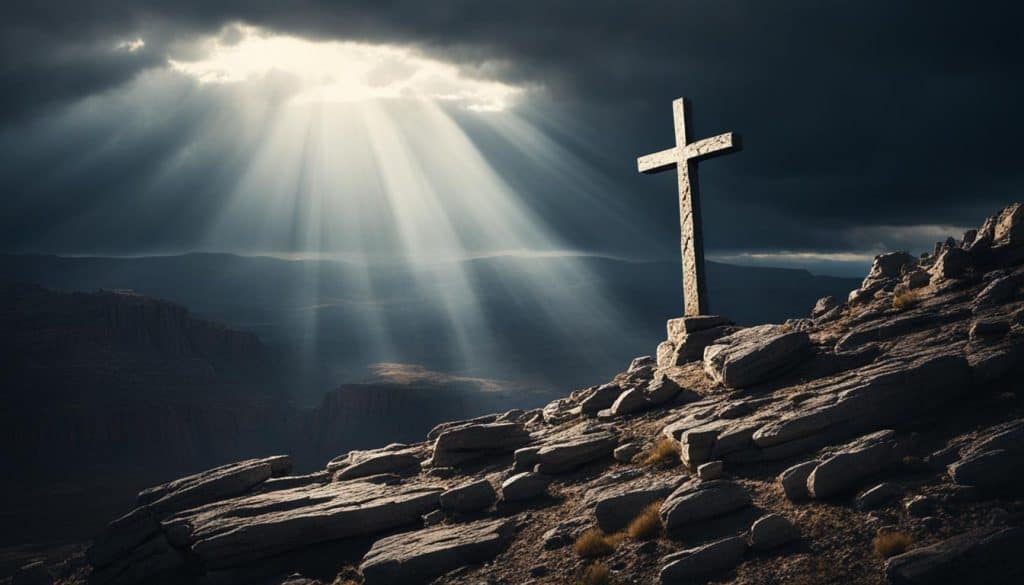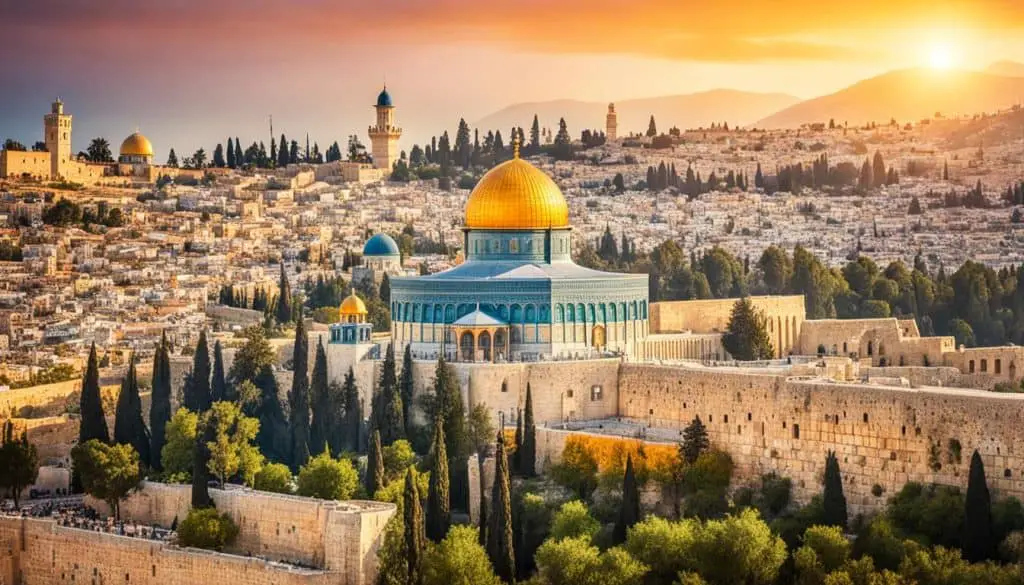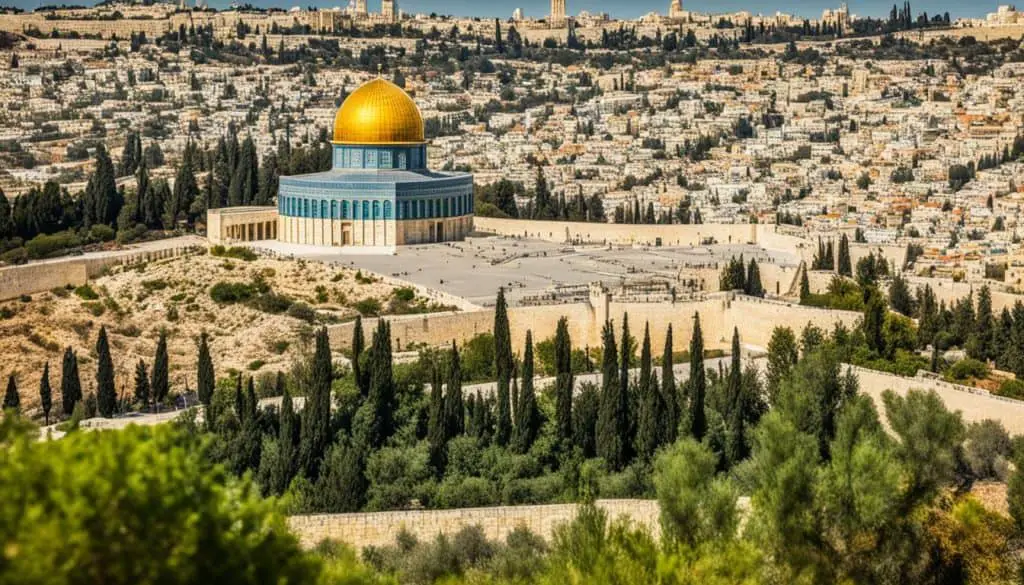Table of Contents
Have you ever wondered about the significance of the Mountains of Zion in biblical history?
How did the geography of Jerusalem shape faith, prophecy, and the enduring legacy of Jesus?
In this article, we will explore the deep connection between Jerusalem and its surrounding mountains, uncovering the profound spiritual truths hidden within their peaks.
From Mount Moriah, where Abraham passed the ultimate test of faith, to Mount Zion, symbolizing eternal kingship, each mountain holds a unique place in the biblical narrative.
The Mount of Olives, a place of prophecy and ascension, witnessed Jesus’ transformative moments, while Mount Calvary became the crucible of redemption.
But it doesn’t end there. The Temple Mount, the pinnacle of Jerusalem, brings together heaven and earth, while Mount Scopus offers a viewpoint to the future. And let’s not forget the mountains encircling Jerusalem, a manifestation of God’s promise.
Are these mountains merely geographical landmarks or do they hold deeper spiritual significance?
Join us as we embark on a journey to unravel the mysteries of the Mountains of Zion and discover the timeless truths they hold in the biblical context.
Mount Moriah: The Foundation of Faith and Sacrifice
Mount Moriah holds a significant place in the biblical narrative as the foundation of faith and sacrifice. The story of Abraham’s test on this mountain showcases the unwavering trust and obedience that exemplify the essence of true faith.
Through this test, God’s plan for Christ’s ultimate sacrifice begins to unfold, foreshadowing the redemptive work to come.
In the book of Genesis, we learn of Abraham’s deep devotion to God and his willingness to follow His commands without question.
God, in turn, put Abraham’s faith to the ultimate test by commanding him to sacrifice his beloved son, Isaac, on Mount Moriah. This profound test served as a testament to Abraham’s unwavering faith and his complete submission to God’s will.
“And he said, Take now thy son, thine only son Isaac, whom thou lovest, and get thee into the land of Moriah; and offer him there for a burnt offering upon one of the mountains which I will tell thee of.” – Genesis 22:2 (KJV)
Abraham’s journey to Mount Moriah must have been filled with both perplexity and burstiness, as he grappled with the divine command and its implications. Yet, he trusted in God’s plan and believed that even in the face of sacrifice, God would provide.
As Abraham and Isaac ascended Mount Moriah, the young Isaac carrying the wood for the offering, they demonstrated their faith and obedience. However, at the last moment, God intervened, providing a ram as a substitute for Isaac.
This act of divine intervention not only spared Isaac’s life but also served as a prophetic foreshadowing of Jesus’ sacrificial death on Mount Calvary, where God Himself would provide the ultimate substitute.
The Symbolism of Mount Moriah
Mount Moriah symbolizes the foundation of faith and sacrifice. This mountain became more than just a physical location – it carried deep spiritual significance. It represents the willingness to submit to God’s will, even when faced with unimaginable challenges.
Through the story of Abraham’s test, Mount Moriah foreshadows the sacrificial death of Jesus on Mount Calvary. Just as Abraham led Isaac up the mountain, God the Father led His only begotten Son to the cross.
The parallels between their willingness to sacrifice and their obedient trust in God’s plan cannot be denied.
By embracing the sacrifice of His Son, God demonstrated His ultimate love for humanity and provided the means for redemption. Mount Moriah thus becomes a foundation, a cornerstone, of faith – reminding us of the depth of love and sacrifice that underlies our relationship with God.
As we reflect on the significance of Mount Moriah, we are drawn to consider our own faith and the sacrifices we may be called to make. Just as Abraham’s faith was tested, we too may face trials and challenges that require us to trust in God’s plan, even when it seems perplexing or full of uncertainty.
Mount Moriah serves as a powerful reminder that our faith and obedience are not in vain. Through our steadfast trust in God, we can experience the fulfillment of His promises and witness the transformative power of sacrificial love in our own lives.
Mount Zion: A Symbol of Eternal Kingship
Mount Zion holds significant symbolism in the biblical narrative, representing eternal kingship and divine authority. This sacred mountain, located in Jerusalem, has been associated with the reign of King David and the establishment of his kingdom.
The legacy of David’s reign on Mount Zion foreshadows the everlasting kingdom of Jesus Christ, the ultimate King of Kings.
David, a humble shepherd chosen by God, ascended to the throne and made Mount Zion the capital of Israel. His reign marked a period of prosperity, security, and spiritual growth for the nation.
The prominence of Mount Zion became a tangible representation of David’s authority and the fulfillment of the divine promise.
Many prophecies throughout the Old Testament point to the eternal kingship that would be established through the descendants of David. These prophecies find their ultimate fulfillment in Jesus Christ, who is the greater Son of David and the rightful heir to the throne.
Through his perfect life, sacrificial death, and resurrection, Jesus inaugurated his everlasting kingdom.
The connection between David’s rule on Mount Zion and Jesus’ royal authority is evident in the New Testament. Jesus is often referred to as the Son of David, signifying his lineage and rightful claim to the throne.
His reign as the King of Kings extends beyond earthly boundaries and transcends time, establishing a kingdom that will never end.
“And in the days of these kings shall the God of heaven set up a kingdom, which shall never be destroyed: and the kingdom shall not be left to other people, but it shall break in pieces and consume all these kingdoms, and it shall stand forever.”
– Daniel 2:44 (KJV)
As believers, we are invited to be citizens of this eternal kingdom, where Jesus reigns in righteousness and love. Mount Zion serves as a reminder of the unshakable foundations upon which this kingdom is built.
It represents the inexorable fulfillment of God’s promises and the hope we have in Jesus’ eternal kingship.
Mount Zion’s significance in biblical history and its association with eternal kingship speak to the profound truth of God’s plan for redemption. It serves as a visual reminder of Jesus’ ultimate victory over sin and death, as well as his ongoing rule and reign in our lives.
The Symbolism of Mount Zion in Scripture
Scripture often uses Mount Zion as a metaphor for God’s dwelling place, emphasizing the spiritual realities that transcend earthly boundaries. It represents the heavenly Jerusalem, where Jesus’ presence and authority are fully manifested.
References to Mount Zion can be found throughout the Old and New Testaments, highlighting its enduring significance as a symbol of God’s faithfulness and eternal rulership. Here are a few key passages:
- Psalm 48:1-2 (KJV):
“Great is the LORD, and greatly to be praised in the city of our God, in the mountain of his holiness. Beautiful for situation, the joy of the whole earth, is mount Zion, on the sides of the north, the city of the great King.” - Isaiah 2:2-3 (KJV):
“And it shall come to pass in the last days, that the mountain of the LORD’s house shall be established in the top of the mountains, and shall be exalted above the hills; and all nations shall flow unto it. And many people shall go and say, Come ye, and let us go up to the mountain of the LORD, to the house of the God of Jacob; and he will teach us of his ways, and we will walk in his paths: for out of Zion shall go forth the law, and the word of the LORD from Jerusalem.” - Hebrews 12:22 (KJV):
“But ye are come unto mount Sion, and unto the city of the living God, the heavenly Jerusalem, and to an innumerable company of angels.”
These passages highlight the exaltation and authority associated with Mount Zion. It is a place where God’s presence dwells, where His reign is established, and where believers are called to journey and find spiritual nourishment.
Mount Zion, as a symbol of eternal kingship, invites us to worship the true King and align our lives with His righteous rule.

The Mount of Olives: A Place of Prophecy and Ascension
The Mount of Olives holds great significance in biblical history, serving as both a place of prophecy and the site of Jesus’ ascension. This sacred mountain, located east of Jerusalem, played a pivotal role in Jesus’ ministry, highlighting his role as a prophet and signaling his promised return.
“And Jesus, when he had found a young ass, sat thereon; as it is written, Fear not, daughter of Zion: behold, thy King cometh, sitting on an ass’s colt.” (John 12:14-15)
Jesus often retreated to the Mount of Olives to pray and teach his disciples. It was on this mountain that he delivered his renowned Olivet Discourse, revealing profound prophecies about the future of Jerusalem and the world.
Prophecies from the Mount of Olives:
- Jesus foretold the destruction of the Jerusalem Temple and warned of false messiahs and signs in the end times.
- He prophesied about the signs of his second coming and the culmination of God’s redemptive plan.
- Jesus spoke about the importance of vigilance and readiness, encouraging his followers to stay faithful until his return.
Furthermore, the Mount of Olives holds significance as the place from which Jesus ascended to heaven following his resurrection. His ascension not only marked the end of his earthly ministry but also paved the way for the outpouring of the Holy Spirit on the day of Pentecost.
Jesus’ ascension from the Mount of Olives carries deep symbolism, illustrating his heavenly authority and his role as the mediator between God and humanity. It serves as a tangible reminder of his promise to return and establish his eternal kingdom.
As believers, the Mount of Olives invites us to reflect on Jesus’ prophecies, reminding us of the urgency to remain faithful and prepared for his return.
In a world filled with uncertainty and turmoil, the Mount of Olives stands as a beacon of hope, assuring us of Jesus’ sovereignty and the fulfillment of God’s divine plan.
Mount Calvary (Golgotha): The Crucible of Redemption
Mount Calvary, also known as Golgotha, holds immense significance as the crucible of redemption. It is the sacred site where Jesus endured the ultimate act of love and sacrifice for humanity.
At Calvary, Jesus willingly faced crucifixion, bearing the weight of our sins and offering us the opportunity for redemption. His selfless act of enduring unimaginable pain and suffering on this very mountain demonstrates the depth of His love for each and every one of us.
The crucifixion on Mount Calvary fulfills numerous prophecies and types found in the Old Testament. These ancient texts foretold of a sacrificial lamb who would bear the sins of the world and bring salvation to humanity. Jesus’ crucifixion aligns with these prophecies, validating His identity as the awaited Messiah.
“With His stripes, we are healed.” – Isaiah 53:5 KJV
The crucible of redemption found on Mount Calvary invites us to reflect on our own lives and the transformative power of Jesus’ sacrifice. It reminds us that through Him, we have the opportunity to find forgiveness, reconciliation, and abundant life.
As you contemplate the depth of Jesus’ sacrifice on Mount Calvary, remember that redemption is not a distant reality but a gift that is available to you today.
Embrace the love and forgiveness offered through the crucible of Calvary, and allow it to guide your life towards a renewed relationship with God.

Let the profound significance of Mount Calvary inspire you to seek a deeper understanding of God’s love and the transformative power of redemption. Through the crucible of Calvary, we can find hope, forgiveness, and eternal life.
The Temple Mount: Where Heaven and Earth Meet
The Temple Mount holds a unique significance as the meeting point of heaven and earth. Its prominent role in biblical history and its association with Jesus’ presence make it a site of profound spiritual and theological importance.
In the Old Testament, the Temple Mount was the location of Solomon’s Temple, the place where God’s presence resided among His people. It was considered the earthly dwelling place of God, where heaven and earth intersected.
The magnificent temple structure, with its intricate design and sacred rituals, served as a tangible reminder of the divine presence and the covenant between God and His chosen people.
Jesus’ presence and activities in the temple challenged and fulfilled the Old Testament understanding of the Temple Mount. He taught and performed miracles within its sacred walls, declaring Himself as the fulfillment of the law and the true embodiment of God’s presence among His people.
“And Jesus went into the temple of God, and cast out all them that sold and bought in the temple, and overthrew the tables of the moneychangers, and the seats of them that sold doves, And said unto them, It is written, My house shall be called the house of prayer; but ye have made it a den of thieves.” – Matthew 21:12-13 (KJV)
Jesus’ actions in the temple demonstrated His authority and His mission to restore true worship and righteousness. By cleansing the temple and challenging the corrupt practices that had infiltrated it, He emphasized the need for genuine devotion and reverence in the presence of God.
In his teachings, Jesus also made references to the temple as His own body, hinting at His ultimate sacrifice as the perfect atonement for sin.
This deep connection between Jesus’ physical presence and the symbolism of the temple further emphasized the Temple Mount’s significance in the fulfillment of God’s plan of salvation.
“Jesus answered and said unto them, Destroy this temple, and in three days I will raise it up.” – John 2:19 (KJV)
Jesus’ words pointed to His crucifixion and resurrection, the ultimate act that bridged the gap between heaven and earth, bringing redemption and reconciliation to humanity.
Through His sacrifice, Jesus made it possible for all believers to enter into a new covenant relationship with God, where His Spirit now resides within their hearts.
The Temple Mount continues to be a place of spiritual pilgrimage and worship, standing as a reminder of the divine connection between heaven and earth.
Its historical and theological significance invites believers to reflect on Jesus’ presence and the fulfillment of God’s plan for salvation.

“And I heard a great voice out of heaven saying, Behold, the tabernacle of God is with men, and he will dwell with them, and they shall be his people, and God himself shall be with them, and be their God.” – Revelation 21:3 (KJV)
As believers, we are reminded that we are now the dwelling place of God’s Spirit, and our lives should reflect the holiness and devotion that characterized the Temple Mount.
Just as the Temple Mount remained a sacred space set apart for worship and encounter with God, we are called to live lives that honor and glorify Him, recognizing that we carry His presence wherever we go.
Mount Scopus: A Viewpoint to the Future
As you stand on Mount Scopus, gazing out at the panoramic vista before you, you can’t help but be captivated by the breathtaking beauty of Jerusalem. This historic mountain, located northeast of the Old City, offers more than just a stunning view. It serves as a viewpoint into the future, providing a unique perspective on the prophetic insights concerning Jerusalem’s future and its relevance to believers today.
Just as Mount Scopus offers a vantage point to behold the physical expanse of Jerusalem, it also invites us to reflect on the spiritual landscape of this sacred city.
Throughout history, Jerusalem has been a focal point for prophecy and God’s divine plan. From Abraham’s encounter with Melchizedek to Jesus’ triumphal entry, Jerusalem’s future has been intricately woven into the fabric of biblical narrative.

“O Jerusalem, Jerusalem, thou that killest the prophets, and stonest them which are sent unto thee, how often would I have gathered thy children together, even as a hen gathereth her chickens under her wings, and ye would not! Behold, your house is left unto you desolate. For I say unto you, Ye shall not see me henceforth, till ye shall say, Blessed is he that cometh in the name of the Lord.” – Matthew 23:37-39 (KJV)
These prophetic words spoken by Jesus capture the essence of Mount Scopus as a viewpoint to the future. Jesus foresaw the destruction and desolation that would befall Jerusalem, along with the rejection of the prophets sent to her.
He offers a glimpse into a future reconciliation when Jerusalem recognizes him as the blessed one who comes in the name of the Lord.
Considering Jerusalem’s Future
What can we learn from Jesus’ prophetic insights into Jerusalem’s future? While the exact details are known only to God, we can draw lessons from the past and the promises of Scripture.
Jerusalem’s history is a testament to God’s faithfulness and his plan for redemption.
As we stand on Mount Scopus and survey the city, we are reminded of the importance of prayer for the peace and prosperity of Jerusalem, as the Psalmist exhorts us: “Pray for the peace of Jerusalem: they shall prosper that love thee” (Psalm 122:6).
Looking ahead, we can also find hope in the promises of a new Jerusalem described in Revelation: “And I John saw the holy city, new Jerusalem, coming down from God out of heaven, prepared as a bride adorned for her husband” (Revelation 21:2).
This future Jerusalem, with Mount Scopus as a witness, will be a place of eternal peace and unity in the presence of God.
The Implications for Believers Today
Mount Scopus not only offers a stunning view of Jerusalem’s landscape, but it also prompts us to contemplate our role as believers in the present age.
Just as Jesus viewed Jerusalem’s future with a mixture of love and sorrow, we are called to have a similar perspective. We are called to love and support the city, praying for its peace and welfare, while also recognizing the realities and challenges it faces.
Moreover, Mount Scopus challenges us to consider our personal journey of faith and our readiness for the future.
Will we be prepared, like the five wise virgins in the parable, or will we be caught unprepared and locked out of the wedding feast?
Jesus’ warnings and prophetic insights should inspire us to live each day with a sense of purpose, anticipating his return and diligently working to advance his kingdom.
| Prophecy | Relevance to Jerusalem’s Future |
|---|---|
| Rebuilding of the Temple | The anticipated rebuilding of the temple in Jerusalem, which continues to be a topic of debate and speculation among believers. |
| Peace and Unity | The promise of peace and unity in Jerusalem, pointing to the eschatological fulfillment of God’s plan for humanity. |
| Restoration of Israel | The restoration and regathering of Israel, a prophetic fulfillment that holds significant implications for Jerusalem’s future. |
As you leave Mount Scopus and descend back into the bustling city, carry with you the prophetic insights revealed from this sacred viewpoint. Let them inform your prayers, your actions, and your faith.
The future of Jerusalem may remain a mystery, but our devotion and readiness for the coming age should be unwavering.
How Does the Geography of Jerusalem Play a Role in the Siege of Zion?
The geography of Jerusalem is significant in the siege of Zion biblical perspective. The city’s high elevation and natural defenses made it a strategic stronghold in ancient times. The surrounding mountains and valleys provided both protection and challenges for those attempting to conquer or defend the city.
The Mountains Around Jerusalem: Encircling God’s Promise
The mountains surrounding Jerusalem not only provide a breathtaking view, but they also carry deep symbolism in the biblical narrative.
These majestic peaks serve as physical reminders of God’s promise and protection over His chosen people. As you gaze upon the mountains around Jerusalem, you are reminded of the enduring faithfulness of God throughout history.
From Mount Moriah, where Abraham displayed his unyielding faith by offering Isaac as a sacrifice, to Mount Zion, the eternal symbol of kingship, each mountain tells a story of God’s sovereign plan. Jesus, the promised Messiah, played a central role in the fulfillment of God’s promises.
His birth, ministry, and sacrificial death are intricately woven into the fabric of Jerusalem’s mountains, elevating their significance to new heights.
As you explore Jerusalem and the mountains that encircle it, you cannot escape the tangible presence of Jesus. The Mount of Olives, where He shared profound prophecies and ascended to heaven, stands as a testament to His divine role in the redemption of mankind.
And Golgotha, or Mount Calvary, where Jesus willingly laid down His life for our salvation, serves as a reminder of God’s love and the ultimate sacrifice that brings redemption and eternal life.
The mountains around Jerusalem are not just geographical features, but they embody God’s promise and His plan of salvation. They speak of the profound impact and significance of Jesus’ life, death, and resurrection.
As you stand in awe of the mountains encompassing Jerusalem, may you be reminded of God’s unwavering faithfulness and the hope that Jesus’ role plays in our lives today and for eternity.




